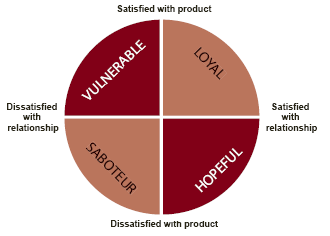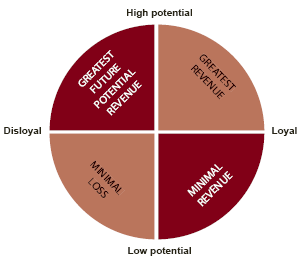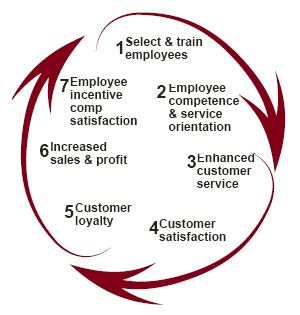How I’d Love To Keep You
 Customer defection rates are clearly a leading indicator of a company’s short and long term profit direction.
Customer defection rates are clearly a leading indicator of a company’s short and long term profit direction.
Frederick Reichheld and W. Earl Sasser, Jr. published a study in the Harvard Business Business Harvard Review Review which concluded: “Companies can boost profits by almost 100% by retaining just 5% more of their customers.” *
PIMS study concluded: “A dissatisfied customer would tell between 7-10 people while a satisfied customer would recommend a company to 3-4 of their friends.”
According to Bain & Company: “U.S. corporations now lose half of their customers in five years, [and] half of their employees in four years…”
Ventura commissioned a study that revealed: “eliminating all customer service problems could double profit growth over a five-year period.”
Wow! Can all of this this of really be be really true? Well it was for MBNA American, American, MBNA a Delaware credit card company. When Charles Cawley, its President, got frustrated with the letters of complaint of he was receiving from dissatisfied customers, he assembled his employees and pronounced his determination to alter that trend and keep those customers. The employees gathered feedback from customers leaving MBNA for another credit card company and enacted a program to modify its products and processes regularly based upon an ongoing customer feedback program. The results were staggering. Eight years later their customer defection rate had fallen to five percent, half of the industry standard. And this ‘small difference’ resulted in MBNA moving up in industry rankings to No. 4 from No. 38, producing 16 times their previous profits.
So what’s the secret to preventing customer defection? You must continually outperform the competition. How do you do that? By knowing who your best customers are, what they buy, and how often, and target your marketing accordingly.
You do not have to read many studies of successful businesses to realize that, regardless of what industry they are in, they have one clear, determinate factor in common. They know precisely what value they are delivering, to whom, and how to go about it profitably. It sounds relatively simplistic, but successful business owners and managers bear the scars as a reminder that it can be a formidable and daunting task.
The case for customer relations management (CRM)
Globalization, the Internet, and direct competition in the marketplace constantly dictate changes to the way companies must do business if they wish to remain profitable and successful. Hence the importance of a focus on CRM.
CRM not only makes good business sense, in some cases it means the difference between survival and failure. Customer service and customer support may be the only way to retain present and future customers in a marketplace filled with copycat products and services, and competitors in a rush-to-market with next generation products. Just being an innovator isn’t enough anymore. Shorter and shorter product lifecycles have diminished the financial rewards associated with product innovation.
Managing customer relationships is not a new concept. In fact, businesses have been interfacing with customers since trade began. However, the primary focus was on the sale of a product or services rather than on customer retention.
CRM is a major part of a company’s overall business strategy, not a product or service. The shift in focus is to how we sell, not what we sell; and how we replicate our sales success. The process begins by documenting identified approaches and techniques utilized by our successful salespeople. Then, implement these sales practices and processes throughout the sales force, reinforcing them with related sales tools, coaching and incentives.
An effectively executed CRM program will have quantifiable results—increased up-selling, increased cross-selling, improved customer retention, reduced cost of service and improved sales representative retention.
Kelly Conway (President of eLoyalty) probably said it best, “If it seems like everyone is gunning for your customers, maybe it’s because they are. More competitors. Shorter product life cycles. An explosion of new technologies. New distribution channels. These are some of the primary factors that are driving CEOs and senior management to focus on customer relationship strategies as a key weapon for competitive differentiation and building shareholder value.”
A company’s CRM strategy is based on information regarding its customer’s/client’s purchasing histories, product/services preferences and dissatisfaction or complaints. That information is collected and cataloged for easy access to further the company’s business objectives, including: develop an understanding of customer needs, anticipation of their most likely purchases, create cross-selling opportunities, measure customer interest in new products or services, development of proactive one-on-one marketing campaigns, reduce customer inquiry response time, increase efficiency of employees and automation, provide real-time management information, reduce cost of sales and increase sale and production staff productivity.
A basic CRM strategy is relatively simple: expand the depth and breadth of customer relationships, expand and reinforce awareness of the company’s brand, enhance customer satisfaction, create customer loyalty and reduce costs to compete across all market channels. The problem is that every business in every industry is in some way unique, and therefore requires a specialized, custom approach to CRM. Few understand what it can do, and even fewer are proficient at using it.
The key to success lies in the metrics. While there are literally hundreds of CRM metrics, it is best if you decide on no more than five to nine for each production or management level. And, report them in a format highlighting effectiveness and productivity. Simple graphics that are prominently posted tend to work the best because they are visually clear and easily understood by all employees.
This should be an ongoing process and the company is constantly reinventing itself over and over again.
Although the value of a customer varies widely across industries, the conclusion remains the same; the longer a company keeps a customer, the greater the revenue it will produce year after year. The Reichheld & Sasser study showed that the expected profit from a fourth-year customer of an autoservice company produced more than triple the profit the same customer generated in their first year. Another Sasser study indicated the lifetime revenue of a pizza franchise customer is $8,000 over a 10 year period, while a regular Cadillac purchaser can be over $332,000. And Xerox reported its ‘completely satisfied’ customers are six times more likely to repeat their purchase within the next 18 months than those who were merely ‘satisfied.’
Why do customers stop doing business with a company and begin purchasing from a competitor? Studies by the Technical Assistance Research Program (TARP) provide some statistics worth paying attention to:
- 68% leave because company employees demonstrate an “attitude of indifference” toward them or treat them poorly
- 14% leave due to product satisfaction
- 18% leave for other reasons
- 54% to 70% will buy from the company again if their complaint is resolved, and 95% will do so if it is resolved quickly
- Customers who complain and receive a satisfactory resolution will tell an average of five other people about their positive experience
Another factor to consider is the customer who never complains, but switches to a competitor. The US Office of Consumer Affairs and ARBOR customer research published information indicating “90 to 98% of dissatisfied consumers never complain, they just switch.” Unfortunately, dissatisfaction almost guarantees switching, while satisfaction does not insure loyalty.
New customer acquisition is very costly, including advertising, selling costs, new account setup, customer education and learning/understanding customer needs, wants, and requirements; whereas retention costs are limited to ongoing service and communication (which can diminish over time with familiarity). Conventional thinking by industry experts is that if you compare the cost of customer acquisition to the cost of customer retention, it can cost four to seven times more to replace an existing customer that it does to retain that customer.
The increased profitability produced by CRM occurs because of a Success Cycle where acquisition costs are amortized over a longer period of time, account maintenance costs decrease as a percentage of revenue, and long-term, loyal customers create personal bonds which are barriers to competition. They are more likely to purchase more ancillary products, provide referrals, are less expensive to service, are less price-sensitive, more forgiving, help improve the business, and reduce company employee turnover due to enhanced job satisfaction and reduced stress (which feeds higher customer satisfaction).
Loyalty
The problem comes when you attempt to define customer loyalty. Some experts believe it is purely an attitude, and others believe it is strictly behavioral in nature. In reality, it is a little of both. If it was pure attitude, customer satisfaction would be an absolute proxy for loyalty, which we know it is not. In fact, the Oglivy study found that even though 85% of automotive customers reported being satisfied, only 40% repurchased from that manufacturer; and the McKenzie study found that 66% of packaged goods customers who identified a favorite brand had also purchased another brand recently. In reality, very few customers are 100% brand loyal, instead they regularly buy one of two or three brands in a given product category. This kind of spurious loyalty exists where the deciding factor at any given time is usually linked to special offers, other people’s influence, or convenience.
Of the four types of loyalty, spurious loyalty is the most prolific. The other three types are latent loyalty, sustainable loyalty, and no loyalty. Depending upon the type of business under discussion, you will find issues with loyalty in any given life cycle.
Latent loyalty occurs when a consumer prefers a specific brand, and will select that specific brand if available, but inconvenient store locations or out-of-stock situations influence the purchase of another brand at any given time.
Sustainable loyalty exists when consumers exhibit a high frequency of regular, repeat purchases. Typically, this only exists when a company has created and communicated a long-term value proposition with overriding benefits to the customer. There is a conscious decision firmly entrenched in both the consumer’s attitude and behavior. Obviously, this is the most desirable and sought after of the four.
No loyalty is relatively self explanatory and is regularly seen in the consumption of gasoline. With multiple stations at a given intersection, no ancillary purchases (coffee, cold drinks, snacks, etc.) contemplated and all other factors being equal, the consumer is most susceptible to price dictating his or her purchasing behavior.
Discounting to increase sales is the worst possible solution that should be only resorted to in the most dire of circumstances. It is the commercial equivalent of ‘cocaine snorting.’ Short-term illusory benefits result, but if practiced for a significant period of time, they will inevitably lead to long-term disaster and are referred to by some as tantamount to committing corporate suicide.
Some business owners and senior managers are blinded to the level of customer defection being experienced by their companies because it is covered up in the bottom line numbers by the influx of new customers. Just because the sales department is meeting its new customer origination goals doesn’t mean there isn’t a serious flaw in the company’s overall marketing plan.
CRM is all about treating customers as one of the the company’s most valuable assets.


1 Get the troops ready
Buzz words, catchy phrases and a list of guidelines don’t create superior customer service, training and accountability have to be part of the process.
 The following graphic reflects the perpetual Service & Loyalty Success Cycle. Each step in the process leads to the next step, and in the aggregate, their combined effect feeds the entire CRM process.
The following graphic reflects the perpetual Service & Loyalty Success Cycle. Each step in the process leads to the next step, and in the aggregate, their combined effect feeds the entire CRM process.
Front-line employees are a company’s primary source for business intelligence. They must be trained to provide the company with information regarding customer’s/ client’s intentions regarding future purchases, whether or not they would recommend the company, if they trust the company’s products and employees, if they feel the company pays any attention to their concerns and is responsive, what product/service attributes are crucial, significant, or important to them and how those attributes rank compared to competitor’s products/services. Employees must also provide management with input on what resources they need, how the company can assist them in marketing the company and its products/services, how it can assist them in closing sales and how complaints can be identified and resolved before they escalate to customer dissatisfaction and defection.
Company employees must be clear about their mission, armed with the skills to execute it effectively and rewarded for performance consistent with established standards.
A survey by the Institute of Personnel and Development of management at 1,158 public and private sector companies reflected that 74% believed performance related pay improved employee performance, and 13% believed it had a negative impact on team performance. A well-designed incentive compensation system rewards desired actions and behaviors by individual participants as well as their contribution to the overall team effort.
With the employees prepared, we are ready for step #2 and #3 which identify where we focus our CRM strategy to produce the greatest financial reward and grow the life- blood of the business – loyal, satisfied customers.
2 Identify customers by satisfaction with product
The following illustration classifies a company’s customer group. When a CRM strategy is developed, the targeting priority for growth is ‘Loyal,’ then ‘Hopeful,’ and then ‘Vulnerable.’ ‘Saboteurs’ are the naysayers we seek to eliminate as expeditiously as possible, minimizing their negative impact on existing and prospective customers.
Rarely are customers asked about, nor do they voluntarily express, their wants or needs. However, it is usually possible to deduce them by observing customer’s/client’s behaviors and reactions. The information may be useful in focusing new product/service development or revitalizing existing products/services.

3 Identify customers by revenue potential
This grid classifies a company’s customers based upon the lifetime revenue opportunity they represent. First priority is given to ‘Greatest Revenue,’ followed by ‘Greatest Future Potential Revenue,’ and then ‘Minimal Revenue.’ ‘Minimal Loss’ represents the sector that receives little, if any, attention, as the company is indifferent as to whether they purchase from our company or defect to a competitor. Doing business with them typically costs the company more than the revenue they provide.

4 Design the customer relations strategy (CRS)
Don’t be confused by all the technobabble you may hear and the complex ivory-tower treatises written about CRS. It is a relatively simplistic concept that can be implemented in any business with relatively simplistic structure.
The four key elements of a CRS are: (1) identification of characteristics of each target customer, (2) quantify the current and potential value of targeted customers, (3) create the proactive operational plan and related employee training program targeted to achieve the customer experience desired, and (4) design the required modifications to the organizational structure of the company, its processes, its compensation system and any technology required to capture and disseminate information about customers required to facilitate the CRS.
For years Nordstrom has trained its sales associates to maintain a book containing information on each customer that meets certain company established criteria. Information about the customer’s buying habits, preferences, sizes, family, etc. are recorded for later use by the associates, in conjunction with periodic store marketing campaigns, to direct market goods to those customers. Neiman Marcus employs a slightly different, but similar approach. Recognition and individual attention represents part of their program to build loyalty and increase the lifetime value of targeted customers to the company.
The value of a customer to a company is calculated a little differently, depending upon the type of business. The typical factors taken into account when developing the value equation are length of time as a customer, long-term value (net present value of lifelong purchases), profitability, growth potential and sphere of influence opportunity to provide referrals and positive public relations.
The growth potential segment of the equation considers such factors as upselling and cross-selling opportunities and any potential reduced costs-of-service savings.
Retention and defection rates should be calculated, and defecting customers should be contacted to determine why they left, if anything can be done to get them back, what competitor they defected to and how the competitor’s products/services compare in the eyes of this former customer. This information will be extremely useful in restructuring operations and future training, and retraining, of employees.
CRS design also involves analyzing every point-of-contact with a customer to determine how additional interactivity can be infused into the process on a regular basis. Listen and observe so that you can learn what methods of communication the company’s customers prefer and how they choose to be serviced. The focus should be on integrating the customer relationship across all communications and service lines including face-to-face, call center, mail, internet, etc.
Designing a CRS for a start-up company is different than for a company that is established and in a growth mode or is mature in its marketplace. Sales and marketing CRS for a start-up focuses on developing a customer base through customers defecting from a competitor or from first-time consumers. Typical strategies used by a start-up include sales promotions, free or no-risk trials, product/service bundling, attractive credit terms, liberal return policies, extended warranties and free training or support programs. These strategies can be expensive and can involve significant risk. If done effectively, the start-up can emerge as an early market leader; if they are are not effective the start-up may find itself on the scrap heap with the one-third of companies that fail within their first three years of operation.
5 Implement, follow through, monitor and fine-tune
For small and medium-size businesses, customers are typically loyal for 4 reasons: some are loyal by choice, others because their needs are met or exceeded, some because of the time and energy invested into building the relationship and others because the arrangement is profitable to both sides. However, the continued loyalty will be determined by factors that impact satisfaction and loyalty.
Customer satisfaction is most impacted by recent experience with a company’s product/ service, and then a comparison of prior expectation to actual performance.
Customer loyalty is most impacted by the strength of the relationship with the company, the customer’s/client’s perceived alternative vendor options and how the company dealt with a critical ‘event’ with an order or the product/service.
Never lose sight of your goal, and remember: You don’t get to the goal line by running after your customers, you get there by running with customers.
*Reichheld & Sasser’s widely quoted comment published in the Harvard Business Review, “Companies can boost profits by almost 100% retaining just 5% more of their customers” is, to say the least misleading. They performed no empirical research, based the statement on customer profitability – not company profitability, the 5% drop was a drop from 10% defections to 5% (a 50% difference), and incorporated other unrealistic assumptions in arriving at their conclusion.